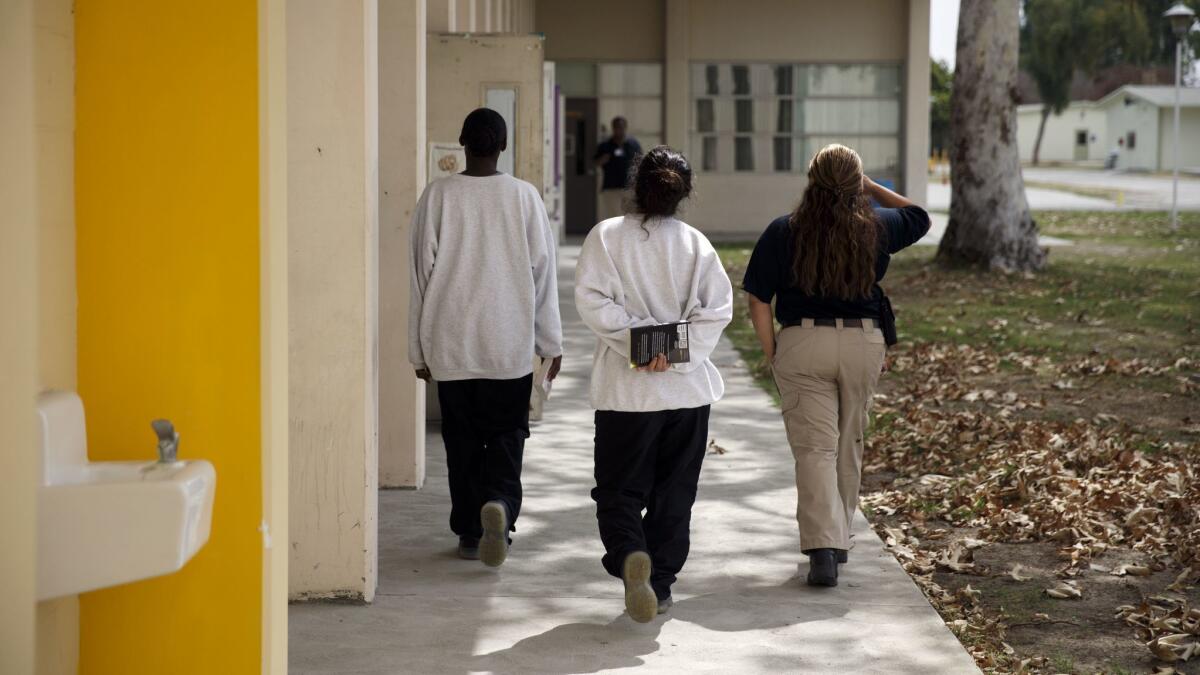Use of pepper spray on juvenile inmates up sharply in recent years, county officials say

- Share via
The use of chemical spray to subdue juvenile offenders in Los Angeles County detention facilities has risen sharply in recent years, prompting the Board of Supervisors on Tuesday to order an investigation into safety conditions for youths and staff.
The supervisors, who have raised concerns about the use of so-called pepper spray in the past, have again been focusing their attention on its deployment inside the nation’s largest juvenile detention system.
Led by Supervisor Mark Ridley-Thomas, the board asked the county’s Office of Inspector General to investigate why the county’s Probation Department, which handles youth detention and rehabilitation, deploys the spray so frequently.
“Use of force is a serious issue and we simply must know more in order to ensure the safety of these young people — and the employees,” Ridley-Thomas said. “Simply stated, no department can police itself, the old axiom. Outside eyes are often essential and, surprisingly enough, can be helpful.”
The heightened interest in the issue arose after the county’s Probation Commission recently received a statistical analysis detailing the use of oleoresin capsicum spray, which the department allows as a last resort to control violent youths.
The information was recently highlighted in an investigative report by KNBC-TV (Channel 4).
The data cited by the station show that chemical spray use increased from 294 incidents in 2015 to 747 last year — a jump of 154%. About 400 incidents were reported through July 2018, suggesting they were on pace to match 2017, according to the data.
The records show an even more dramatic increase in the number of incidents at juvenile halls, where offenders go before their cases are adjudicated, as opposed to juvenile camps, which serve as longer-term rehabilitation facilities.
County probation officials said they noticed the overall trend last year and, since then, have taken steps to reduce detention officers’ reliance on the spray, including by offering them extra training on de-escalation techniques.
Chief Probation Officer Terri McDonald and other probation officials say that as a result, the use of chemical spray has declined in recent months, though the department is not expected to release statistics for 2018 until early next year.
McDonald highlighted a combination of factors that she believes is driving the trend, including an effort to keep low-risk offenders out of detention and a decision to stop isolating high-risk detainees who cause problems
She said officers have struggled to keep order as violence against youths and staff has increased in recent years.
The department has a detailed use-of-force policy, advising officers to try other methods to keep order — including reasonable physical force — before deploying spray. But some, McDonald said, have relied too heavily on the spray to avoid getting into trouble for physical altercations with juveniles during violent incidents.
“They’re struggling through really a changed philosophy of how we expect our staff to engage” with youths, she said. “It’s difficult. The staff have difficult jobs.”
Hans Liang, president of the AFSCME Local 685 union, which represents detention service officers, acknowledged that the use of spray had increased. He said many officers are overworked and inexperienced — and operating, at times, in fear.
“A lot of the staff are also wary about touching the kids,” he said. “It’s very easy for them to go to pepper spray, and it’s also an effective tool.”
The questions over spray use mark the latest flare-up over the agency’s ability to manage its population of juvenile offenders. The U.S. Justice Department has previously required county officials to implement reforms to improve conditions and to prevent the abuse of young offenders.
Several years ago, a federal monitoring team found that the county had reduced the overuse of pepper spray — an issue that apparently persists.
“I got pepper sprayed so many times that I got immune to it,” Kent Mendoza, a former juvenile detainee, told the supervisors on Tuesday.
“We need to get rid of pepper spray,” he added. “These are kids, and kids should be treated like kids.”
Liang and other county officials noted that many of the youths inside detention facilities are high-risk and have gang histories. Some outweigh the officers.
Supervisors also expressed concern about the safety and training of officers.
Ridley-Thomas said he hoped the investigation, unanimously approved by supervisors on Tuesday, would include recommendations on how to improve conditions inside the facilities. The board asked for a report within 45 days.
“All of us are concerned about the trauma that these youngsters have endured, and we maintain that these events have retraumatized them,” he said.
More to Read
Sign up for Essential California
The most important California stories and recommendations in your inbox every morning.
You may occasionally receive promotional content from the Los Angeles Times.











